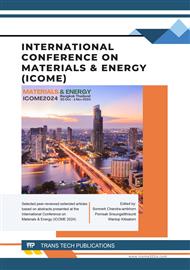[1]
P. Navarro-Simarro, L. Gomez-Gomez, O. Ahrazem, A. Rubio-Moraga, Food and human health applications of edible mushroom by-products, N Biotechnol. 81 (2024) 43-56.
DOI: 10.1016/j.nbt.2024.03.003
Google Scholar
[2]
V. Bell, C. Silva, J. Guina, T.H. Fernandes, Mushrooms as future generation healthy foods, Front Nutr. 9 (2022) 1050099.
DOI: 10.3389/fnut.2022.1050099
Google Scholar
[3]
F. Ayimbila, S. Keawsompong, Nutritional Quality and Biological Application of Mushroom Protein as a Novel Protein Alternative, Curr Nutr Rep. 12 (2023) 290-307.
DOI: 10.1007/s13668-023-00468-x
Google Scholar
[4]
M. Bonelli, A. Kerschbaumer, K. Kastrati, K. Ghoreschi, M. Gadina, L.X. Heinz, J.S. Smolen, D. Aletaha, J. O'Shea, A. Laurence, Selectivity, efficacy and safety of JAKinibs: new evidence for a still evolving story, Ann Rheum Dis. 83 (2024) 139-160.
DOI: 10.1136/ard-2023-223850
Google Scholar
[5]
H. Li, J. Gao, F. Zhao, X. Liu, B. Ma, Bioactive Peptides from Edible Mushrooms-The Preparation, Mechanisms, Structure-Activity Relationships and Prospects, Foods. 12 (2023).
DOI: 10.3390/foods12152935
Google Scholar
[6]
M.A.R. Mazumder, S. Sukchot, P. Phonphimai, S. Ketnawa, M. Chaijan, L. Grossmann, S. Rawdkuen, Mushroom-Legume-Based Minced Meat: Physico-Chemical and Sensory Properties, Foods. 12 (2023).
DOI: 10.3390/foods12112094
Google Scholar
[7]
S. Habtemariam, The Chemistry, Pharmacology and Therapeutic Potential of the Edible Mushroom Dictyophora indusiata (Vent ex. Pers.) Fischer (Synn. Phallus indusiatus), Biomedicines. 7 (2019).
DOI: 10.3390/biomedicines7040098
Google Scholar
[8]
W. Ruksiriwanich, C. Khantham, P. Linsaenkart, T. Chaitep, P. Rachtanapun, K. Jantanasakulwong, Y. Phimolsiripol, A.R. Jambrak, Y. Nazir, W. Yooin, S.R. Sommano, P. Jantrawut, M. Sainakham, J. Tocharus, S. Mingmalairak, K. Sringarm, Anti-inflammation of bioactive compounds from ethanolic extracts of edible bamboo mushroom (Dictyophora indusiata) as functional health promoting food ingredients, International Journal of Food Science and Technology. 57 (2021) 110-122.
DOI: 10.1111/ijfs.15338/v2/response1
Google Scholar
[9]
Y. Hua, Q. Gao, L. Wen, B. Yang, J. Tang, L. You, M. Zhao, Structural characterisation of acid- and alkali-soluble polysaccharides in the fruiting body of Dictyophora indusiata and their immunomodulatory activities, Food Chemistry. 132 (2012) 739-743.
DOI: 10.1016/j.foodchem.2011.11.010
Google Scholar
[10]
S. Bastiaan-Net, W. Chanput, A. Hertz, R.D. Zwittink, J.J. Mes, H.J. Wichers, Biochemical and functional characterization of recombinant fungal immunomodulatory proteins (rFIPs), Int Immunopharmacol. 15 (2013) 167-175.
DOI: 10.1016/j.intimp.2012.11.003
Google Scholar
[11]
Y. Gao, Y. Wang, Y. Wang, Y. Wu, H. Chen, R. Yang, D. Bao, Protective Function of Novel Fungal Immunomodulatory Proteins Fip-lti1 and Fip-lti2 from Lentinus tigrinus in Concanavalin A-Induced Liver Oxidative Injury, Oxid Med Cell Longev. 2019 (2019) 3139689.
DOI: 10.1155/2019/3139689
Google Scholar
[12]
T.Y. Lin, W.J. Hua, H. Yeh, A.J. Tseng, Functional proteomic analysis reveals that fungal immunomodulatory protein reduced expressions of heat shock proteins correlates to apoptosis in lung cancer cells, Phytomedicine. 80 (2021) 153384.
DOI: 10.1016/j.phymed.2020.153384
Google Scholar
[13]
Y. Zhang, R. Zhou, F. Liu, T.B. Ng, Purification and characterization of a novel protein with activity against non-small-cell lung cancer in vitro and in vivo from the edible mushroom Boletus edulis, Int J Biol Macromol. 174 (2021) 77-88.
DOI: 10.1016/j.ijbiomac.2021.01.149
Google Scholar
[14]
C. Marty, C. Lacout, N. Droin, J.P. Le Couedic, V. Ribrag, E. Solary, W. Vainchenker, J.L. Villeval, I. Plo, A role for reactive oxygen species in JAK2 V617F myeloproliferative neoplasm progression, Leukemia. 27 (2013) 2187-2195.
DOI: 10.1038/leu.2013.102
Google Scholar



